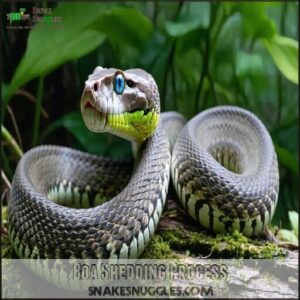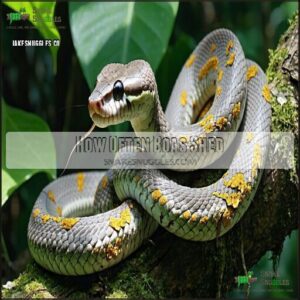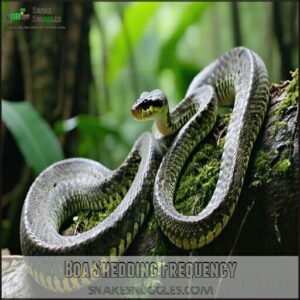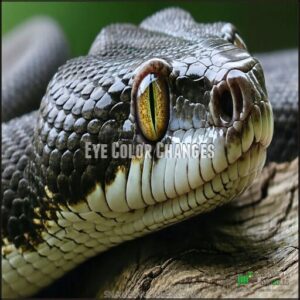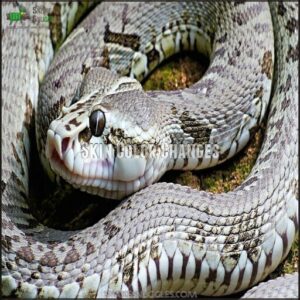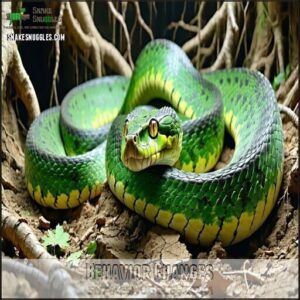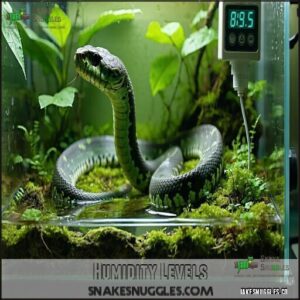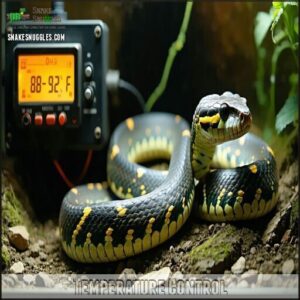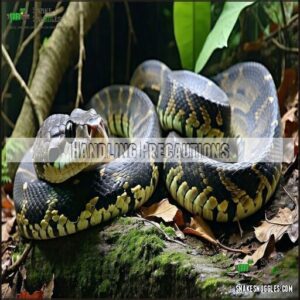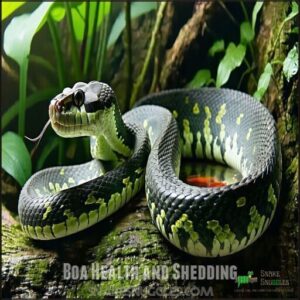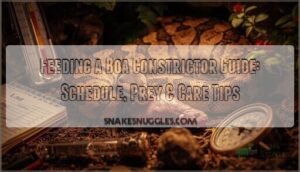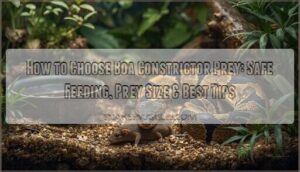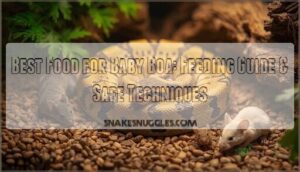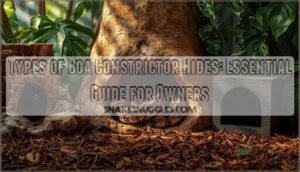This site is supported by our readers. We may earn a commission, at no cost to you, if you purchase through links.
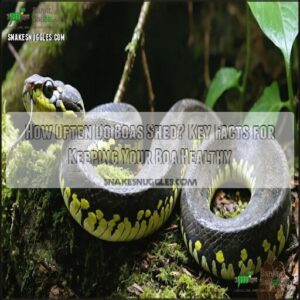
How often boas shed depends primarily on their growth rate – younger, faster-growing snakes shed more frequently than mature ones.
Your boa’s diet, health, and environmental conditions also influence shedding frequency.
During the shedding process, you’ll observe your boa’s eyes turning bluish (called "blue phase") about 1-2 weeks before shedding begins.
Maintaining proper humidity levels between 50-70% helps guarantee a complete, healthy shed.
Understanding your boa’s shedding cycle reveals important clues about its overall wellbeing.
Table Of Contents
- Key Takeaways
- Boa Shedding Process
- How Often Boas Shed
- Boa Shedding Frequency
- Shedding Duration
- Boa Constrictor Shedding Signs
- Helping Boas Shed
- Boa Health and Shedding
- Frequently Asked Questions (FAQs)
- How often do Boas shed?
- How often do boa constrictors shed their skin?
- What is the first sign of a boa constrictor shedding?
- Do boa constrictors eat after they shed?
- Why does my Boa shed come off in pieces?
- What happens if I don’t handle my boa constrictor for weeks?
- How do I tell if my boa is shedding?
- How often do 5 year old ball pythons shed?
- How often do adult sand boas shed?
- Do boas eat during shedding periods?
- Conclusion
Key Takeaways
- Your boa’s shedding frequency varies with age—juveniles shed every 4-8 weeks while adults shed every 1-4 months, directly reflecting their growth rate.
- You’ll notice pre-shedding signs like cloudy blue eyes, dull skin, and behavioral changes about 7-10 days before the actual shed begins.
- You need to maintain 80-90% humidity during shedding periods to ensure a complete, healthy shed that comes off in one piece.
- You shouldn’t handle your boa during shedding as they’re more defensive and stressed, especially during the "blue phase" when their vision is impaired.
Boa Shedding Process
When your boa sheds, it goes through a fascinating, natural process that replaces its old, dull skin with a fresh layer.
Understanding each stage, from the cloudy eyes to the final peel, allows you to spot issues early and keep your snake healthy.
Pre-Shedding Indicators
Before boa shedding, watch for cloudy eyes and dull skin—classic boa shedding signs.
Their skin may sag slightly, with a blueish hue creeping in. Expect behavior changes too, like irritability or hiding more often.
These snake shedding signs mean your reptile is gearing up to shed. Once you spot these clues, focus on creating the perfect environment to support them.
Shedding Stages
Shedding unfolds in stages.
- Initial Stage: Colors dull, patterns blur, and boa shedding signs like cloudy eyes appear.
- Skin Loosening: Scales lift slightly, signaling the reptile shedding cycle is advancing.
- Sloughing Process: Old skin peels head-to-tail as the boa rubs against surfaces.
- Final Stage: The snake shedding cycle completes, leaving fresh, vibrant skin behind.
Post-Shedding Care
After your boa sheds, it’s important to check for stuck shed, especially around the tail and eyes.
A gentle skin check can reveal any leftover patches.
Bright eyes, shiny, smooth skin, and active behavior signal a successful shed.
If needed, soak your boa in warm water for eyecap removal.
Proper handling techniques are important to remember after shedding.
Avoid handling after shedding to reduce stress.
| Observation | Action | Tools Needed | Outcome |
|---|---|---|---|
| Stuck shed | Soak in warm water | Warm water, bin | Stuck skin loosens |
| Dull tail tip | Check for shedding | Fingers, light | Clean removal |
| Cloudy eyecaps | Eyecap removal | Cotton bud | Clear, bright eyes |
| Restless behavior | Monitor humidity | Hygrometer, spray |
Active, calm boa ripping shed completes.
The table provides a quick reference for common issues and their solutions, helping you to identify and address any problems that may arise after your boa sheds, ensuring a healthy and happy pet.
How Often Boas Shed
Boas shed their skin regularly to accommodate growth and maintain healthy scales.
Shedding frequency depends on factors like age, growth rate, and environmental conditions, with younger boas usually shedding more often than adults, which can be considered a complete concept related to their growth rate.
Factors Affecting Shedding Frequency
A boa constrictor’s shedding cycle depends on several factors.
Humidity effects, temperature impact, and dietary influence all play critical roles. Low humidity or improper temperatures disrupt shedding frequency, causing health concerns.
Environmental conditions, like consistent moisture, facilitate smooth cycles. Genetic predisposition and boa growth also matter—each snake’s unique blueprint influences how often their shedding frequency adapts to changes.
Keep everything balanced!
Age and Growth Rate
Young snakes experience rapid growth spurts, making juvenile shedding more frequent—up to nine times a year.
As boas mature, their shedding frequency slows, matching their reduced growth rate.
Adult intervals occur every few months, influenced by boa growth and dietary impact.
Genetics also play a role, affecting the boa shedding cycle and how often your snake sheds, with rapid growth and genetics being key factors.
Environmental Conditions
Think of your boa’s habitat like its personal spa.
Environmental factors, like humidity levels and temperature gradients, directly impact shedding frequency.
Aim for 60-70% humidity and provide cozy hide boxes.
Too little humidity can lead to shedding issues, while incorrect temperatures stress boas.
Substrate choice and enclosure size also matter—keep it clean and comfortable for happy, healthy shedding.
Provide the right conditions to ensure your boa thrives, as incorrect temperatures can cause significant stress.
Boa Shedding Frequency
Young boas shed more often than adults because they’re growing rapidly.
While adults shed less frequently as their growth slows.
Shedding intervals usually range from every 4-6 weeks for young boas to every few months for adults, depending on factors like age, diet, and humidity.
Young Boas Shedding
Many young boa constrictors experience rapid shedding cycles due to their accelerated growth spurts.
Your neonate boa will shed more frequently than adults, typically:
- Up to 9 times annually during their first year
- Every 4-6 weeks during growth phases
- More often with proper nutrition and diet influence
- Less predictably when environmental conditions fluctuate
This frequent snake shedding is completely normal and indicates your baby boa is developing healthily.
The frequent shedding is a natural part of their development, and with proper care, your boa constrictor will thrive.
Adult Boas Shedding
Unlike their younger counterparts, adult boas typically shed just 4-5 times per year as their growth rate naturally slows.
Your boa constrictor’s shedding frequency can be influenced by diet, environmental conditions, and overall health.
Well-fed adults in proper habitats maintain consistent shedding patterns, while inadequate care may lead to irregular shedding or stuck shed issues.
Regular, complete sheds indicate your snake is thriving, and this can be seen as a sign of overall health.
Shedding Intervals
Your boa’s shedding intervals typically follow a predictable pattern, though individual variation exists.
Adult boas shed approximately every 4-6 weeks, while this frequency decreases with age.
Dietary impact is significant – well-fed boas shed more often.
Captivity effects and seasonal variation can influence the boa constrictor shedding cycle.
Monitor your snake’s shedding consistency, as irregular patterns might indicate health issues requiring attention.
Shedding Duration
Your boa’s complete shedding process typically takes seven to fourteen days from the first signs of cloudy eyes to the final removal of old skin.
You’ll notice the process begins with cloudy eyes that clear after three to four days, followed by the actual skin removal as your snake moves across rough surfaces to shed from nose to tail.
Average Shedding Time
From start to finish, the average shedding time for a boa constrictor typically spans seven to fourteen days. During this complete shedding process, your boa will pass through distinct phases—from cloudy eyes to skin loosening to final sloughing.
The dance of renewal unfolds over fortnight’s time—your boa’s ancient ritual of transformation from dull to dazzling scales.
Most boas finish shedding within two weeks, with the actual skin removal happening relatively quickly once the preparation stages are complete. Time variations exist between individual snakes, depending on their health and environment.
Maintaining proper humidity helps to prevent incomplete shedding issues.
Factors Affecting Shedding Duration
While the shedding process has a typical timeframe, several factors can stretch or compress this duration.
Temperature plays a key role—warmer environments speed up metabolic processes, while cooler temps slow everything down.
Hydration levels directly impact how easily old skin separates, and stress factors like handling or improper enclosure size can delay shedding.
Your boa’s dietary influence, genetic variation, and health status all affect how quickly reptile shedding completes.
Shedding Completion
When your boa finishes shedding, you’ll find the complete shed should come off in one piece from nose to tail.
After the post-shed check, look carefully for any retained eyecaps or stuck sheds, particularly on the tail tip.
Quality shedding indicates good health, while incomplete sheds may signal problems in your boa constrictor shedding cycle.
Shedding complications require prompt shedding assistance to prevent more serious issues.
Boa Constrictor Shedding Signs
You’ll notice distinctive physical changes in your boa constrictor before shedding, including eyes turning cloudy blue-white and skin becoming dull with less defined patterns.
Your snake’s behavior may also change during this time, with increased defensiveness and reduced interest in food as the shedding process begins, which can be a clear indication of the shedding process.
Eye Color Changes
While your boa’s shedding cycle varies, one unmistakable signal is the eye color change.
Your boa’s eyes will turn milky blue-white approximately 7-10 days before shedding begins.
This opaque appearance, often called the "blue phase," indicates your snake is preparing to shed.
During this milky eye stage, your boa’s vision becomes impaired, making them more defensive.
Always check for stuck eye caps after shedding completes, as these can cause complications if not properly removed.
Skin Color Changes
Noticing color changes in your boa’s skin provides reliable shedding indicators.
You’ll see its vibrant patterns fading and a blue hue developing across its body.
Scale discoloration becomes apparent as the outer layer loosens.
During the final stages, dullness indicates imminent shedding, while white skin appears just before the actual shed begins.
Watch for cloudy skin and the distinctive dulling of your snake’s normally bright coloration, which are key signs that the snake is about to shed, indicated by a change in its appearance to a duller state, and the dulling of its color.
Behavior Changes
While you’re monitoring skin changes, you’ll also notice distinct behavior changes during your boa’s shedding cycle.
Your normally docile pet may display increased aggression and defensive postures.
Most boas show reduced appetite or stop eating entirely before shedding.
Watch for hiding behavior and restlessness as your snake seeks rough surfaces to rub against.
These preshedding behaviors are normal responses to the stress and vulnerability they feel when their senses are compromised.
Helping Boas Shed
You can support your boa’s shedding process by maintaining humidity levels between 80-90% when their eyes turn cloudy and providing rough surfaces like branches for them to rub against.
It’s best to avoid handling your snake during this vulnerable period, as they’re nearly blind during the milky-eyed stage and may become more defensive while they work to remove their old skin.
Humidity Levels
Boost your boa’s humidity levels to 80-90% when those cloudy eyes appear.
This moisture-rich environment is essential for a clean, one-piece shed. You’ll want to monitor readings with a hygrometer placed at ground level where your snake spends time.
A boa hygrometer’s availability makes humidity monitoring easier.
Consider adding a large water dish, misting the enclosure daily, or including damp sphagnum moss to maintain ideal humidity for your boa constrictor’s shedding needs.
Temperature Control
While proper humidity aids shedding, temperature control is equally important for your boa’s shedding process.
Proper heat management supports healthy shedding in boa constrictors:
- Maintain a basking spot of 88-92°F to stimulate metabolism and promote shedding
- Create a heat gradient allowing your snake to self-regulate (75-85°F cool side)
- Lower night temperatures by 5-10°F to mimic natural conditions
- Use a reliable thermostat to prevent dangerous overheating risks
- Monitor shedding frequency as temperature fluctuations can disrupt normal cycles
To further support successful shedding, remember to maintain proper humidity in their enclosure, which is crucial for a healthy shedding process and overall snake care.
Handling Precautions
During your boa’s shedding cycle, hands-off is the golden rule. Boas become more defensive and irritable when shedding, increasing bite risk.
| Shedding Phase | Handling Approach | Stress Level |
|---|---|---|
| Pre-shed | Minimal contact only | High |
| Active shedding | No handling | Extreme |
| Post-shed | Wait 24-48 hours | Moderate |
For safer interactions, consider using specialized handling equipment. Resume safe handling practices only after your snake has completely shed and returned to normal behavior. This reduces stress and prevents potential harm.
Boa Health and Shedding
Your boa’s shedding pattern serves as a direct indicator of its overall health, with irregular or incomplete sheds often signaling potential problems like dehydration, nutritional deficiencies, or illness.
You’ll need to monitor each shed carefully, maintaining proper humidity levels of 80-90% and appropriate temperatures to guarantee your snake can shed completely in one piece.
This is essential for preventing complications like stuck eyecaps or tail shed, which can be detrimental to your boa’s well-being.
Shedding Issues
Now that you’ve set up the ideal shedding environment, let’s address common shedding issues your boa might experience.
When shedding doesn’t go smoothly, several problems can emerge:
- Stuck shed – particularly dangerous around tail tips and eye caps
- Respiratory issues from improper humidity levels
- Skin infections developing under retained skin
- Mite infestations causing shedding difficulties
- Over-shedding indicating possible nutritional or environmental stress
These shedding problems require prompt attention to prevent complications and discomfort for your snake, as they can lead to serious health issues if not addressed properly, including respiratory issues and skin infections.
Health Concerns
Keeping an eye on your boa’s shedding pattern can head off serious health concerns.
Stuck sheds often lead to skin infections or circulation problems when left untreated. Mite infestations frequently interfere with normal shedding cycles, while respiratory issues may develop from improper humidity levels.
Diet impact is significant too—nutritional deficiencies directly affect your boa constrictor’s shedding frequency.
Remember, infrequent or irregular shedding is often the first warning sign of underlying health issues.
Insufficient humidity can cause fluid balance issues, leading to shedding problems.
Preventative Measures
Maintaining your boa’s health requires consistent preventative measures. Clean the enclosure weekly to prevent infections that affect healthy boa shedding.
Balance your snake’s diet to support regular shedding cycles. Reduce stress by limiting handling during pre-shed periods.
Monitor your boa constrictor shedding patterns to catch issues early. Keep humidity between 80-90% when eyes turn blue.
Use appropriate products to maintain enclosure hygiene. Remember, proper care isn’t complicated—it’s about regular monitoring and responding to your snake’s needs.
Frequently Asked Questions (FAQs)
How often do Boas shed?
Your baby boa will shed like crazy – up to 9 times yearly.
As they age, this decreases to 4-5 times annually for adults.
Shedding frequency depends on growth rate, diet, and environmental conditions.
How often do boa constrictors shed their skin?
Young boa constrictors shed up to 9 times yearly, while adults typically shed 4-5 times annually. Your boa’s shedding frequency depends on its age, growth rate, diet, and environmental conditions.
What is the first sign of a boa constrictor shedding?
You’ll notice your boa’s eyes turning cloudy and milky blue-white about 7-10 days before shedding begins. This "blue phase" is accompanied by slightly duller coloration and patterns becoming less distinct.
Do boa constrictors eat after they shed?
Yes, your boa constrictor will typically resume eating after shedding is complete.
They’ll usually be hungry since many don’t eat during pre-shed and shedding phases.
Wait about 24 hours before offering food.
Why does my Boa shed come off in pieces?
Over 70% of incomplete boa sheds occur due to inadequate humidity.
Your boa’s shed comes off in pieces because the enclosure isn’t humid enough.
Try increasing humidity to 80-90% during shedding periods.
What happens if I don’t handle my boa constrictor for weeks?
Your boa will remain healthy but may become less accustomed to handling.
When you resume contact, it might be more defensive or stressed.
Consistent, gentle handling helps maintain tameness and positive human associations.
How do I tell if my boa is shedding?
Your boa’s skin will turn as cloudy as morning fog before shedding.
Look for milky blue-white eyes, dull coloration, saggy skin around the head and neck, and decreased appetite.
You’ll notice these signs 7-10 days beforehand, which can be a crucial period to observe the changes, including dull coloration.
How often do 5 year old ball pythons shed?
Your 5-year-old ball python will typically shed every 6-8 weeks.
Adult pythons shed less frequently than juveniles, who shed every 4-6 weeks.
You’ll notice cloudy eyes when it’s approaching shedding time.
How often do adult sand boas shed?
By jove, you’ll notice your adult sand boas typically shed about once a month.
This frequency decreases as they age, allowing you to anticipate these natural molting cycles with greater predictability.
Do boas eat during shedding periods?
Typically, your boa won’t eat during shedding periods.
They usually lose interest in food when their eyes turn blue.
It’s best to delay feeding until after they’ve completed the shedding process.
Conclusion
Regularly recognizing how often do boas shed will reveal vital insights into your snake’s health.
By monitoring their shedding cycles—typically every 4-8 weeks for juveniles and 1-4 months for adults—you’ll stay ahead of potential problems.
Maintain proper humidity, provide appropriate hiding spots, and adjust environmental conditions as needed.
Your attentive care during these natural processes guarantees your boa remains healthy and comfortable throughout its life.
Remember, a clean, complete shed indicates a thriving boa constrictor, and regular monitoring is essential for its well-being.
- https://www.reptifiles.com/red-tailed-boa-care/sick-boa/burns/
- https://nationalzoo.si.edu/animals/boa-constrictor
- https://www.boa-constrictors.com/en/Interesting_facts_about_Boa_constrictor/Boa_constrictor_Care/Shedding/Shedding_Problems
- https://vcahospitals.com/know-your-pet/snakes-problems
- https://arborviewah.com/wp-content/uploads/2023/03/Boa-ConstrictorRed-Tailed-Boa-Guide.pdf

